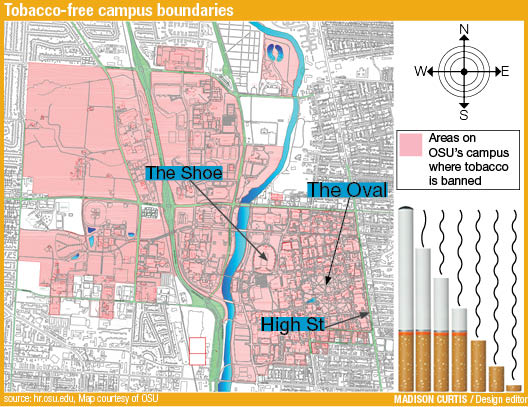Ohio State students, staff and faculty officially have boundaries for where they can get their tobacco fix.
The university’s tobacco-free policy, which went into effect Jan. 1, was recently updated to include a map showing the boundaries of where exactly the tobacco-free policy applies.
The policy does not apply to the South Campus Gateway, but it reaches as far north as past Ackerman Road to areas as far south as King Avenue, and from High Street to areas as far west as North Star Road, according to the boundary map.
OSU spokesman Gary Lewis said the ban applies to a variety of properties.
“The tobacco-free policy applies to all owned, leased or managed university property including regional campuses and Ohio State medical care centers throughout the state,” Lewis said in an email Friday. “Additionally, it applies to golf courses, airports, nature centers, and parking lots and garages, including state and personal vehicles parked on university property.”
Since the ban went into effect, some campus-area employees, including Amber Rapier, a shift supervisor at the Starbucks location at 1782 N. High St., said they have seen an increase in the number of people leaving campus to use tobacco products.
“I notice people who start leaving class or something, they’ll start smoking as they cross the street, because you can’t smoke on campus,” Rapier said. “I’m sure people are still doing it, even though they’re not supposed to. But I’ve definitely noticed more coming this way from campus.”
Tyler Cooper, a manager at Tobacco International, located at 18 E. 13th Ave., said he’s seen more faculty members coming off campus to smoke than students.
“I’ve definitely seen more faculty coming across High Street than students,” Cooper said. “OSU’s campus is large and far-spreading. I think designated smoking spots would make a little more sense than a complete ban.”
Veronica Bruns, a third-year in biology, said she supports the tobacco ban, but she still sees people smoking on campus. Bruns said she thinks there would have to be punishments for violating the policy in place for the ban to be fully effective.
“Smoking is bad for your health, and it not only affects the person who is smoking, but also the people around them. I do not personally smoke, but just getting a whiff of smoke in your face, it’s not something you want to be around,” Bruns said. ”I don’t think it will end up working very well if there are no punishments. I feel like if there was actually some work on enforcing it, it would really work.”
Lewis said while there is still no defined punishment for people who violate the policy, there are avenues for discipline.
“Currently, there is not a prescribed method for dealing with violators of the policy. As with many of our policies, final decisions for enforcement measures lie with unit/department heads and/or residential advisers/directors. Enforcement could run along a continuum from doing nothing to letting someone go/suspending them,” Lewis said. “Students would not be dismissed.”
Tobacco ban violations are not handled by the University Police, but instead by the Office of Human Resources.
The campus-wide ban was announced in 2013, and was set to take effect Aug. 1. In August, however, university officials said the ban would not be enforced until 2014.
Besides cigarettes, OSU’s tobacco ban includes tobacco chew, e-cigarettes, snuff and snus, which is a “spitless,” moist powder tobacco pouch, according to the American Cancer Society.



